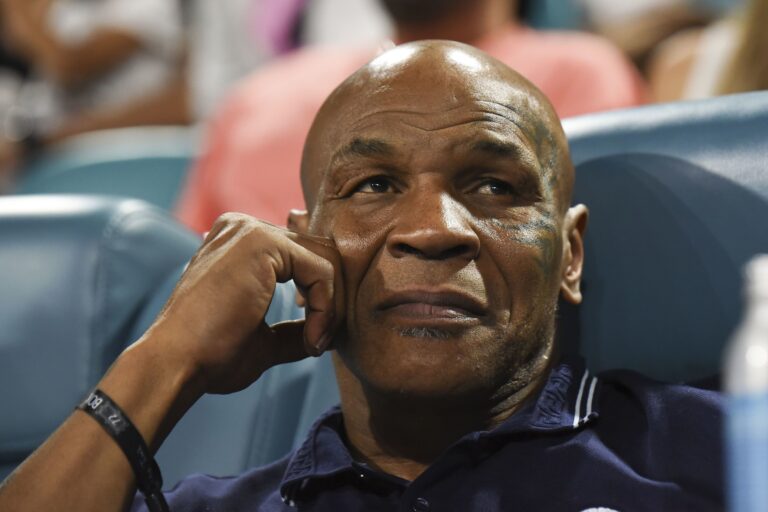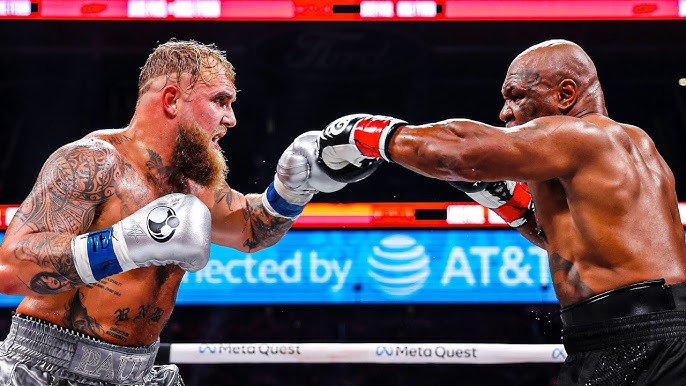From “Kid Dynamite” to a cannabis tycoon, take stock of the tumultuous journey of Mike Tyson, a boxing legend whose life story packs more punches than his knockout record.
Who is Mike Tyson?
Michael Gerard Tyson is an American former professional boxer whose career spanned from 1985 to 2005 and briefly in 2024.
Known by his nicknames “Iron Mike”, “Kid Dynamite” and “The Baddest Man on the Planet”, Tyson is widely regarded as one of the greatest heavyweight boxers in history. He achieved the status of undisputed world heavyweight champion from 1987 to 1990.
Tyson’s early career was marked by a series of devastating knockouts. He won his first 19 professional fights by knockout, with 12 of those victories coming in the first round.
In November 1986, at the age of 20 years, 4 months and 22 days, he became the youngest boxer ever to win a heavyweight title. He was also the first heavyweight boxer to simultaneously hold the WBA, WBC and IBF titles, unifying them in succession.
In June 1988, he became the lineal champion by knocking out Michael Spinks in 91 seconds.
However, Tyson’s career was not without its setbacks. In 1990, he suffered a stunning upset loss to Buster Douglas, losing his undisputed heavyweight championship.
In 1992, he was convicted of rape and served three years in prison. After his release, he made a comeback, regaining the WBA and WBC titles in 1996, making him one of the few boxers to have regained a heavyweight championship after losing it.
His 1997 rematch with Evander Holyfield ended in disqualification after Tyson bit Holyfield’s ears. Later in his career, he lost to Lennox Lewis in a world heavyweight title fight.
In November 2024, his fight against Jake Paul became the biggest boxing gate in US history outside of Las Vegas.
Known for his ferocious boxing style and intimidating presence, Tyson was ranked 16th on The Ring magazine’s list of 100 greatest punchers of all time and first on ESPN’s list of “The Hardest Hitters in Heavyweight History.”
He has been inducted into the International Boxing Hall of Fame and the World Boxing Hall of Fame.
Outside of boxing, Tyson has appeared in popular media, including the films Rocky Balboa and The Hangover.
Mike Tyson Age
Mike Tyson was born on June 30, 1966. Tyson is 59 years old as of July 2025.
Mike Tyson Height
Mike Tyson is 5 ft 10 in (1.78 m) tall.
Where is Mike Tyson from?
Mike Tyson was born in Brooklyn, New York City.
He grew up in the Brownsville neighbourhood, an area known for its high crime rates. His early life in this environment significantly shaped his character and later boxing career.
Mike Tyson Amateur Career
Mike Tyson’s amateur career was marked by significant success, showcasing his raw talent and power.
He won gold medals at the 1981 and 1982 Junior Olympic Games, defeating Joe Cortez and Kelton Brown, respectively. In the latter bout, Brown’s corner threw in the towel in the first round, highlighting Tyson’s dominant style.
In 1984, Tyson secured another gold medal at the National Golden Gloves held in New York, beating Jonathan Littles.
However, his amateur record was not without its setbacks. He fought Henry Tillman twice, losing both bouts by decision. Tillman later went on to win heavyweight gold at the 1984 Summer Olympics in Los Angeles.
Despite these losses, Tyson’s amateur career demonstrated his potential and set the stage for his explosive professional boxing journey.
Mike Tyson Biography
Michael Gerard Tyson was born on June 30, 1966, in Fort Greene, Brooklyn, New York City.
He had an older brother Rodney and an older sister Denise, who tragically died of a heart attack in February 1990.
Tyson’s mother, Lorna Mae (Smith) Tyson, born in Charlottesville, Virginia, faced challenging circumstances.
Tyson’s birth certificate listed Purcell Tyson as his biological father, a humble cab driver from Jamaica.
However, the man Tyson knew as his father was Jimmy Kirkpatrick, a pimp from Grier Town, North Carolina. Kirkpatrick abandoned the family around the time Mike was born, leaving Lorna Mae to raise her children alone.
The family initially lived in Bedford-Stuyvesant, but financial difficulties forced them to move to Brownsville when Tyson was 10 years old.
He grew up in neighbourhoods with high crime rates. His first fight, as he recalled, was against a larger youth who had harmed one of his pigeons.
Tyson frequently engaged in petty crimes and fights, leading to 38 arrests by the age of 13.
He was sent to the Tryon School for Boys in Johnstown, New York, where his boxing talent was discovered by Bobby Stewart, a counsellor and former boxer.
Stewart introduced Tyson to Cus D’Amato, a boxing manager and trainer. Tyson dropped out of high school as a junior, but later received an honorary Doctorate in Humane Letters from Central State University in 1989.
Kevin Rooney also trained Tyson, with occasional assistance from Teddy Atlas until D’Amato dismissed Atlas when Tyson was 15. Tyson’s mother died when he was 16, and D’Amato became his legal guardian.
Tyson’s amateur career was notable. He won gold medals at the 1981 and 1982 Junior Olympic Games, defeating Joe Cortez and Kelton Brown respectively.
In 1984, he won the gold medal at the National Golden Gloves in New York, beating Jonathan Littles. However, he lost twice to Henry Tillman.
Tyson made his professional debut on March 6, 1985, at the age of 18, defeating Hector Mercedes by TKO.
He won 26 of his first 28 fights by knockout, 16 of them in the first round. His first nationally televised bout was on February 16, 1986, against Jesse Ferguson, who he defeated by TKO.
In July, he defeated Marvis Frazier by knockout. In 1986, he also defeated Jose Ribalta. Cus D’Amato died in November 1985.
On November 22, 1986, Tyson won his first title fight against Trevor Berbick, becoming the youngest heavyweight champion in history at 20 years and 4 months old.
He added the WBA and IBF titles in 1987, defeating James Smith and Tony Tucker. He defended his titles against Tyrell Biggs, Larry Holmes and Tony Tubbs.
On June 27, 1988, he defeated Michael Spinks in 91 seconds.
However, Tyson’s personal problems began to surface. His marriage to Robin Givens was ending, and he parted ways with manager Bill Cayton and trainer Kevin Rooney.
In 1989, he defeated Frank Bruno and Carl “The Truth” Williams. On February 11, 1990, he lost his undisputed championship to Buster Douglas.
After the loss, Tyson defeated Henry Tillman and Alex Stewart. He then defeated Donovan “Razor” Ruddock twice in 1991. A scheduled fight with Evander Holyfield was postponed due to Tyson’s injury.
Tyson was convicted of rape in 1992 and released in 1995. He won comeback fights against Peter McNeeley and Buster Mathis Jr. In 1996, he regained the WBC title against Frank Bruno and the WBA title against Bruce Seldon.
On November 9, 1996, Tyson faced Evander Holyfield, losing by TKO. In their rematch on June 28, 1997, Tyson was disqualified for biting Holyfield’s ears. His boxing license was rescinded in July 1997 and restored in October 1998.
In January 1999, Tyson defeated Francois Botha, but legal problems arose again. He was imprisoned for assaulting two motorists.
He returned to boxing, defeating Julius Francis, Lou Savarese, and Andrew Golota. His victory over Golota was changed to a no-contest after he tested positive for marijuana.
In 2002, Tyson fought Lennox Lewis for the heavyweight championship, losing by knockout.
He defeated Clifford Etienne in 2003 and later filed for bankruptcy in August 2003.
In 2004, he lost to Danny Williams. On June 11, 2005, he retired after losing to Kevin McBride.
In August 2007, Tyson pleaded guilty to drug possession and driving under the influence.
In his 2013 autobiography, he admitted to using other people’s urine to pass doping tests.
Mike Tyson Bite
Evander Holyfield versus Mike Tyson II, billed as “The Sound and the Fury,” and later infamously known as “The Bite Fight,” took place on June 28, 1997, at the MGM Grand Garden Arena in Paradise, Nevada.
This professional boxing match for the WBA World Heavyweight Championship became one of the most notorious in boxing history due to Tyson biting Holyfield’s ears.
The rematch followed their first encounter seven months prior where Holyfield, despite being an underdog, defeated Tyson by TKO.
Initially, Mitch Halpern was assigned as the referee, but Tyson’s camp objected, citing concerns about headbutts in the previous fight. Halpern withdrew, and Mills Lane was brought in as a late replacement.
Holyfield dominated the early rounds. In the first round, Holyfield stunned Tyson with an overhand right. In the second, an accidental headbutt from Holyfield opened a cut over Tyson’s right eye, exacerbating Tyson’s frustration. Tyson had complained about headbutts in their first fight.
The third round descended into chaos. Tyson started without his mouthpiece, returning to his corner to insert it. He then bit Holyfield’s right ear, tearing off a piece of cartilage which he spat out. Mills Lane stopped the fight temporarily.
After consulting with officials and a ringside physician who cleared Holyfield to continue, Lane deducted two points from Tyson.
Lane explained his decision to Tyson, who claimed the injury was from a punch, a claim Lane refuted.
Later in the match, Tyson bit Holyfield’s left ear. Lane did not immediately notice this second bite and the fight continued until the round ended.
Upon discovering the second bite, the match was stopped. Tyson was disqualified and Holyfield retained his title.
The incident led to Tyson losing his boxing license, though it was later reinstated. The fight’s bizarre conclusion cemented its place in boxing infamy.


